Mittens required on Pluto
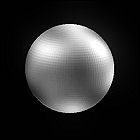 Scientists are already aware that Pluto is really cold, but recent observations suggest that it’s even colder than they had imagined. New radio telescope measurements of Pluto’s surface indicate that it’s a brisk -382 degrees Fahrenheit (scientists had earlier estimated a positively summery -364). Part of the reason for the slight chill in the air – if indeed there was any there – is that Pluto is on the outbound train. The tiny planet’s highly inclined orbit isn’t centered around the sun, while the solar system’s other worlds are more or less centered; part of Pluto’s orbit carries it further away from the sun and “under” the plane shared by the other planets. Curiously enough, however, the surface of Charon – Pluto’s nearly-identical-twin moon – is determined to be warmer than Pluto itself. The readings are taken by the Submillimeter Array in Hawaii by astronomers at the Harvard-Smithsonian Center for Astrophysics.
Scientists are already aware that Pluto is really cold, but recent observations suggest that it’s even colder than they had imagined. New radio telescope measurements of Pluto’s surface indicate that it’s a brisk -382 degrees Fahrenheit (scientists had earlier estimated a positively summery -364). Part of the reason for the slight chill in the air – if indeed there was any there – is that Pluto is on the outbound train. The tiny planet’s highly inclined orbit isn’t centered around the sun, while the solar system’s other worlds are more or less centered; part of Pluto’s orbit carries it further away from the sun and “under” the plane shared by the other planets. Curiously enough, however, the surface of Charon – Pluto’s nearly-identical-twin moon – is determined to be warmer than Pluto itself. The readings are taken by the Submillimeter Array in Hawaii by astronomers at the Harvard-Smithsonian Center for Astrophysics.
Eris
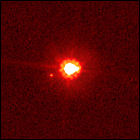 Astronomers at Palomar Observatory discover a body beyond Neptune’s orbit that initial observations show is larger than Pluto. Eris is quickly dubbed the tenth planet by the media and the scientific community, and it is later found to have a small moon of its own in a close orbit, which is later named Dysnomia. But events overtake Eris and Dysnomia before the science textbooks have a chance to be rewritten to include a tenth planet: Eris becomes a case study in an ongoing debate within the International Astronomical Union about the definition of a planet. In 2006, the IAU will establish a set of parameters which determine that Eris isn’t a planet – and then rewrites the history books by deciding that Pluto isn’t either.
Astronomers at Palomar Observatory discover a body beyond Neptune’s orbit that initial observations show is larger than Pluto. Eris is quickly dubbed the tenth planet by the media and the scientific community, and it is later found to have a small moon of its own in a close orbit, which is later named Dysnomia. But events overtake Eris and Dysnomia before the science textbooks have a chance to be rewritten to include a tenth planet: Eris becomes a case study in an ongoing debate within the International Astronomical Union about the definition of a planet. In 2006, the IAU will establish a set of parameters which determine that Eris isn’t a planet – and then rewrites the history books by deciding that Pluto isn’t either.
2004 Robot Hall Of Fame inductees
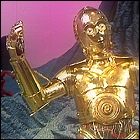
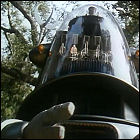 Carnie Mellon University inducts five new members to its Robot Hall Of Fame at a press event promoting the movie adaptation of Isaac Asimov’s I, Robot. The 2004 inductees, again split almost evenly between fictional and real robots, are:
Carnie Mellon University inducts five new members to its Robot Hall Of Fame at a press event promoting the movie adaptation of Isaac Asimov’s I, Robot. The 2004 inductees, again split almost evenly between fictional and real robots, are:
- Astro Boy (1951, manga/anime character)
- Robby The Robot (1956, from Forbidden Planet)
- Shakey (1966, Stanford Research Institute – first robot capable of autonomous tasks)
- C-3PO (1977, from Star Wars)
- ASIMO (2000, Honda – humanoid robot capable of navigating uneven terrain)
Judges for the 2004 Hall include SimCity creator Wil Wright, roboticist Ruzena Bajcsy and Apple co-founder Steve Wozniak.
Sedna
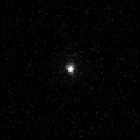 Astronomers using NASA’s Spitzer Space Telescope announce the discovery a tiny planet, with a diameter of only 2,000 kilometers, orbiting the sun three billion kilometers past Pluto. That places it at an average ten billion kilometers away from Earth – with a solar year that lasts around 10,000 years. Sedna is also spotted from ground-based telescopes as well, using the initial observations made by the Spitzer Telescope; its diameter, only 300 kilometers less than that of Pluto, intensifies the “Pluto as a planet” debate that has been raging since the discovery of Quaoar.
Astronomers using NASA’s Spitzer Space Telescope announce the discovery a tiny planet, with a diameter of only 2,000 kilometers, orbiting the sun three billion kilometers past Pluto. That places it at an average ten billion kilometers away from Earth – with a solar year that lasts around 10,000 years. Sedna is also spotted from ground-based telescopes as well, using the initial observations made by the Spitzer Telescope; its diameter, only 300 kilometers less than that of Pluto, intensifies the “Pluto as a planet” debate that has been raging since the discovery of Quaoar.
2003 Robot Hall Of Fame inductees
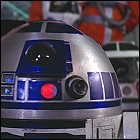
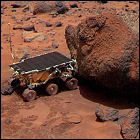 The first four inductees – two real and two fictional – are inducted into the Robot Hall Of Fame created by Carnegie Mellon University’s School of Computer Science.
The first four inductees – two real and two fictional – are inducted into the Robot Hall Of Fame created by Carnegie Mellon University’s School of Computer Science.
- Unimate (1961, General Motors) – the first robotic arm used in car assembly
- HAL-9000 (1968, from 2001: a space odyssey)
- R2-D2 (1977, from Star Wars)
- Sojourner (1996, NASA) – the first successful Mars rover
The panel of judges in future years will pare down the number of nominations awarded to fictional creations. R2-D2 actor Kenny Baker and Douglas Rains, the voice actor behind HAL, are in attendance.
Uranus moons Hubble
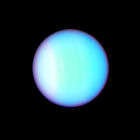 Astronomers using the Hubble Space Telescope discover two new moons of Uranus that eluded detection during Voyager 2’s 1986 flyby: Cupid and Mab. Both small, dark bodies that orbit closer to Uranus than any of the planet’s large satellites, Cupid and Mab raise the number of known Uranian satellites above 20. Mab’s orbit keeps it within the planet’s outermost ring, while Cupid’s orbit is only 500 miles further out than that of Belinda, one of the small moons discovered in 1986 by Voyager 2. Cupid is the tiniest of the inner moons of Uranus, roughly 11 miles in diameter.
Astronomers using the Hubble Space Telescope discover two new moons of Uranus that eluded detection during Voyager 2’s 1986 flyby: Cupid and Mab. Both small, dark bodies that orbit closer to Uranus than any of the planet’s large satellites, Cupid and Mab raise the number of known Uranian satellites above 20. Mab’s orbit keeps it within the planet’s outermost ring, while Cupid’s orbit is only 500 miles further out than that of Belinda, one of the small moons discovered in 1986 by Voyager 2. Cupid is the tiniest of the inner moons of Uranus, roughly 11 miles in diameter.
The sun that coughed
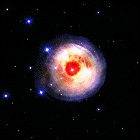 Following up on observations from Earth-based telescopes, NASA’s Hubble Space Telescope is pointed toward the star V838 Monocerotis – an object of very little previous interest – to discover why it’s suddenly the brightest thing in the entire Milky Way Galaxy. What Hubble sees surprises scientists on the ground: a “shell” of matter surrounding the star, illuminated from within and expanding outward into space (actual photo sequence seen here). What astronomers had seen previously was the illumination of the dust cloud, which is much larger than the star itself. Scientists theorize that the expanding dust cloud is not an indication of a supernova, but a sign that V838 Monocerotis is expanding, expelling gas and then shrinking again. The star is over 20,000 light years from Earth.
Following up on observations from Earth-based telescopes, NASA’s Hubble Space Telescope is pointed toward the star V838 Monocerotis – an object of very little previous interest – to discover why it’s suddenly the brightest thing in the entire Milky Way Galaxy. What Hubble sees surprises scientists on the ground: a “shell” of matter surrounding the star, illuminated from within and expanding outward into space (actual photo sequence seen here). What astronomers had seen previously was the illumination of the dust cloud, which is much larger than the star itself. Scientists theorize that the expanding dust cloud is not an indication of a supernova, but a sign that V838 Monocerotis is expanding, expelling gas and then shrinking again. The star is over 20,000 light years from Earth.
The giant who melted
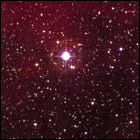 NASA’s Hubble Space Telescope makes an astonishing discovery while observing one of the first planets discovered beyond Earth’s solar system. The gas giant planet designated HD 209458b, orbiting the star HD 209458 in the constellation of Pegasus, 150 light years from Earth, is losing its atmosphere. Slightly larger than Jupiter, but locked into a dizzyingly tight orbit around its star (only 4,000,000 miles, with its “year” lasting less than half of an Earth week), HD 209458b’s atmosphere is boiling away into space thanks to the heat of the nearby star. This leads to a new exoplanet classification, “Hot Jupiters,” used to describe gas giants in similarly suicidal orbits. The core of HD 209458b will probably not last long once the last remnants of its atmosphere dissipate.
NASA’s Hubble Space Telescope makes an astonishing discovery while observing one of the first planets discovered beyond Earth’s solar system. The gas giant planet designated HD 209458b, orbiting the star HD 209458 in the constellation of Pegasus, 150 light years from Earth, is losing its atmosphere. Slightly larger than Jupiter, but locked into a dizzyingly tight orbit around its star (only 4,000,000 miles, with its “year” lasting less than half of an Earth week), HD 209458b’s atmosphere is boiling away into space thanks to the heat of the nearby star. This leads to a new exoplanet classification, “Hot Jupiters,” used to describe gas giants in similarly suicidal orbits. The core of HD 209458b will probably not last long once the last remnants of its atmosphere dissipate.
Quaoar
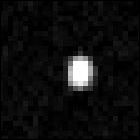 NASA’s Hubble Space Telescope spots an object beyond the orbit of Pluto, and approximately half the size of Pluto – the largest object discovered in the solar system in over 70 years. With a circular orbit that’s a billion miles further from the sun than Pluto, the body is determined to be approximately 800 miles in diameter. Quaoar is believed to be the largest Kuiper Belt object discovered to date, though its thunder will be stolen a few years later with the discovery of Eris and the demotion of Pluto to a dwarf planet.
NASA’s Hubble Space Telescope spots an object beyond the orbit of Pluto, and approximately half the size of Pluto – the largest object discovered in the solar system in over 70 years. With a circular orbit that’s a billion miles further from the sun than Pluto, the body is determined to be approximately 800 miles in diameter. Quaoar is believed to be the largest Kuiper Belt object discovered to date, though its thunder will be stolen a few years later with the discovery of Eris and the demotion of Pluto to a dwarf planet.
Impact in Siberia
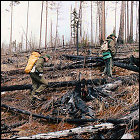 An object from space, possibly as much as 300 feet in diameter, explodes in mid-air at night over the mountainous region near Bodaybo, a village in Irkutsk, Siberia, showering the land below with its fragments and destroying nearly 40 square miles of forest. Neither debris nor the actual “impact” site of the airborne explosion are discovered until 2003, when an expedition discovers the destroyed forest land, comparing the sight to the infamous 1908 Tunguska impact zone. Traces of tritium and slightly radioactive cesium and cobalt are discovered surrounding the impact area, possibly indicating a comet nucleus that broke up in Earth’s atmosphere. Despite the size of the object, it was not detected before its near-impact with Earth.
An object from space, possibly as much as 300 feet in diameter, explodes in mid-air at night over the mountainous region near Bodaybo, a village in Irkutsk, Siberia, showering the land below with its fragments and destroying nearly 40 square miles of forest. Neither debris nor the actual “impact” site of the airborne explosion are discovered until 2003, when an expedition discovers the destroyed forest land, comparing the sight to the infamous 1908 Tunguska impact zone. Traces of tritium and slightly radioactive cesium and cobalt are discovered surrounding the impact area, possibly indicating a comet nucleus that broke up in Earth’s atmosphere. Despite the size of the object, it was not detected before its near-impact with Earth.
GOES-12 goes a little haywire
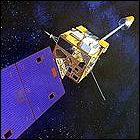 NOAA’s GOES-12 Geostationary Operational Environmental Satellite is launched from Cape Canaveral into geosynchronous orbit to monitor weather patterns over the United States. It will be held in reserve until 2003, when it will be moved to the GOES-EAST position to replace GOES-8, which is nearly out of fuel. Though GOES-11 has been in orbit longer than GOES-12, this satellite is activated first to use a solar imaging instrument (which will fail in 2006). Once in its active position, GOES-12 suffers from chronic thruster problems due to errors made during wiring of its primary and backup maneuvering thrusters; one outage will prove to be severe enough that the still-active GOES-10 must cover GOES-EAST coverage. In 2008, another thruster glitch will cause GOES-12 to temporarily lose all attitude control. In 2010, GOES-13 will replace GOES-12 in the GOES-EAST orbit thanks to the continued attitude control issues; GOES-12 remains in orbit as a backup.
NOAA’s GOES-12 Geostationary Operational Environmental Satellite is launched from Cape Canaveral into geosynchronous orbit to monitor weather patterns over the United States. It will be held in reserve until 2003, when it will be moved to the GOES-EAST position to replace GOES-8, which is nearly out of fuel. Though GOES-11 has been in orbit longer than GOES-12, this satellite is activated first to use a solar imaging instrument (which will fail in 2006). Once in its active position, GOES-12 suffers from chronic thruster problems due to errors made during wiring of its primary and backup maneuvering thrusters; one outage will prove to be severe enough that the still-active GOES-10 must cover GOES-EAST coverage. In 2008, another thruster glitch will cause GOES-12 to temporarily lose all attitude control. In 2010, GOES-13 will replace GOES-12 in the GOES-EAST orbit thanks to the continued attitude control issues; GOES-12 remains in orbit as a backup.
GOES-11 goes weather watching…after a while
 After over a year of launch delays, NOAA’s GOES-11 Geostationary Operational Environmental Satellite is launched from Cape Canaveral into geosynchronous orbit to monitor weather patterns over the United States. It will be held in reserve until 2006, when it will be moved to the GOES-WEST position to replace GOES-10, which is nearly out of fuel. The longevity of its predecessor means that GOES-11 doesn’t begin its active daily weather-watching until a year after the end of its projected five-year design lifespan, and GOES-12 will actually go active before GOES-11. GOES-11 will remain in service through the end of 2011, when it will boost itself into a higher-than-geostationary “graveyard” orbit and shut down.
After over a year of launch delays, NOAA’s GOES-11 Geostationary Operational Environmental Satellite is launched from Cape Canaveral into geosynchronous orbit to monitor weather patterns over the United States. It will be held in reserve until 2006, when it will be moved to the GOES-WEST position to replace GOES-10, which is nearly out of fuel. The longevity of its predecessor means that GOES-11 doesn’t begin its active daily weather-watching until a year after the end of its projected five-year design lifespan, and GOES-12 will actually go active before GOES-11. GOES-11 will remain in service through the end of 2011, when it will boost itself into a higher-than-geostationary “graveyard” orbit and shut down.
GOES-10 lifts off
 NOAA’s GOES-10 Geostationary Operational Environmental Satellite is launched from Cape Canaveral into a geosynchronous orbit to monitor weather patterns over the United States. GOES-10 suffers significant hardware issues upon reaching orbit, including the failure of sun-tracking sensors to orient its solar panels, and it will be over a year before it is pressed into operational service in the GOES-WEST orbit by the failure of GOES-9’s attitude control system. GOES-10 will operate there until 2006, when, upon the launch of GOES-11, it takes up a new position, GOES-SOUTH, monitoring South America and watching for Atlantic Ocean hurricane and tropical storm formation. It will be briefly moved back into the GOES-EAST orbit in late 2007, and with just enough maneuvering fuel left to boost it, it will finally be retired to the above-geostationary “graveyard” orbit in 2009.
NOAA’s GOES-10 Geostationary Operational Environmental Satellite is launched from Cape Canaveral into a geosynchronous orbit to monitor weather patterns over the United States. GOES-10 suffers significant hardware issues upon reaching orbit, including the failure of sun-tracking sensors to orient its solar panels, and it will be over a year before it is pressed into operational service in the GOES-WEST orbit by the failure of GOES-9’s attitude control system. GOES-10 will operate there until 2006, when, upon the launch of GOES-11, it takes up a new position, GOES-SOUTH, monitoring South America and watching for Atlantic Ocean hurricane and tropical storm formation. It will be briefly moved back into the GOES-EAST orbit in late 2007, and with just enough maneuvering fuel left to boost it, it will finally be retired to the above-geostationary “graveyard” orbit in 2009.
Hubble spots “space tornadoes”
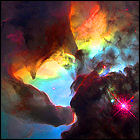 NASA’s Hubble Space Telescope does some interstellar storm spotting, capturing an image of funnel-cloud-shaped structures in the Lagoon Nebula, 5,000 light years away from Earth. Similar to the star-forming structures in the Eagle Nebula, the Lagoon Nebula’s star-birthing clouds are seen to be twisting into tornado-like shapes, possibly due to interactions of gases with extreme hot and cold temperatures, not unlike the weather processes leading to tornado formation on Earth.
NASA’s Hubble Space Telescope does some interstellar storm spotting, capturing an image of funnel-cloud-shaped structures in the Lagoon Nebula, 5,000 light years away from Earth. Similar to the star-forming structures in the Eagle Nebula, the Lagoon Nebula’s star-birthing clouds are seen to be twisting into tornado-like shapes, possibly due to interactions of gases with extreme hot and cold temperatures, not unlike the weather processes leading to tornado formation on Earth.
Fort Smith, Arkansas Tornado
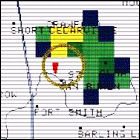 A small but powerful tornado touches down near theLogBook.com’s home office in downtown Fort Smith, Arkansas shortly after 11pm. It traverses two more counties, and kills three people, before dissipating. This is part of a larger tornado outbreak that has plagued much of Oklahoma earlier in the day. The storm is later judged to be an F3 tornado.
A small but powerful tornado touches down near theLogBook.com’s home office in downtown Fort Smith, Arkansas shortly after 11pm. It traverses two more counties, and kills three people, before dissipating. This is part of a larger tornado outbreak that has plagued much of Oklahoma earlier in the day. The storm is later judged to be an F3 tornado.
Hubble peeks at Pluto
 After decades of the tiny object being seen only as a point of light in even the best telescopic images, the Hubble Space Telescope makes the first survey of the surface of Pluto. Even without the distortion introduced by Earth’s atmosphere, Hubble’s best shots of Pluto are vague due to the distance from Earth to Pluto, but they mark the first time that even blurry surface detail has been seen. The new images help NASA gain support for a Pluto flyby mission in the 21st century, which will eventually be named New Horizons.
After decades of the tiny object being seen only as a point of light in even the best telescopic images, the Hubble Space Telescope makes the first survey of the surface of Pluto. Even without the distortion introduced by Earth’s atmosphere, Hubble’s best shots of Pluto are vague due to the distance from Earth to Pluto, but they mark the first time that even blurry surface detail has been seen. The new images help NASA gain support for a Pluto flyby mission in the 21st century, which will eventually be named New Horizons.
Hubble’s “pillars of creation”
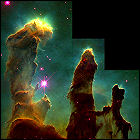 The Hubble Space Telescope, observing M16 (also known as the Eagle Nebula), takes what may be its most famous image: towering clouds of rapidly-evaporating interstellar gas which scientists theorize are the birthplace of new stars. The huge, light-years-long hydrogen clouds are dubbed evaporating gaseous globules, or EGGs; astronomers also call the structure a stellar nursery. The image quickly becomes a mainstay of the media, making appearances in Babylon 5 and the movie Contact.
The Hubble Space Telescope, observing M16 (also known as the Eagle Nebula), takes what may be its most famous image: towering clouds of rapidly-evaporating interstellar gas which scientists theorize are the birthplace of new stars. The huge, light-years-long hydrogen clouds are dubbed evaporating gaseous globules, or EGGs; astronomers also call the structure a stellar nursery. The image quickly becomes a mainstay of the media, making appearances in Babylon 5 and the movie Contact.
GOES-9 goes up
 NOAA’s GOES-9 Geostationary Operational Environmental Satellite is launched from Cape Canaveral into a geosynchronous orbit now designated GOES-EAST to monitor weather patterns over the United States; its predecessor, GOES-8, remains in orbit in the GOES-WEST position. GOES-9’s hardware configuration is identical to that of GOES-8, and both suffer minor glitches which will be corrected prior to launch in the GOES-10 satellite. GOES-9 will remain in the GOES-EAST orbit until it is retired from active weather-watching duty in 1998 due to those hardware problems, though it will be pressed back into served and leased to Japan to replace one of that country’s weather satellites between 2003 and 2005. GOES-9 will finally be retired in 2007.
NOAA’s GOES-9 Geostationary Operational Environmental Satellite is launched from Cape Canaveral into a geosynchronous orbit now designated GOES-EAST to monitor weather patterns over the United States; its predecessor, GOES-8, remains in orbit in the GOES-WEST position. GOES-9’s hardware configuration is identical to that of GOES-8, and both suffer minor glitches which will be corrected prior to launch in the GOES-10 satellite. GOES-9 will remain in the GOES-EAST orbit until it is retired from active weather-watching duty in 1998 due to those hardware problems, though it will be pressed back into served and leased to Japan to replace one of that country’s weather satellites between 2003 and 2005. GOES-9 will finally be retired in 2007.
Jupiter eats a comet
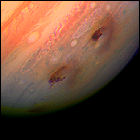 Its collision with the solar system’s largest planet predicted over a year in advance, the fragments of Comet Shoemaker-Levy 9 begin impacting Jupiter’s atmosphere in an astronomical event lasting six days. With Earth-based telescopes watching, as well as cameras and instruments on the Hubble Space Telescope, Galileo and even Voyager 2, huge explosions are witnessed as the cometary chunks slam into Jupiter’s southern hemisphere at over 200,000 miles per hour, leaving dark “scars” larger than the diameter of Earth visible on the planet’s atmosphere and releasing more heat than the surface of the sun. Galileo is still over a year away from arriving at Jupiter.
Its collision with the solar system’s largest planet predicted over a year in advance, the fragments of Comet Shoemaker-Levy 9 begin impacting Jupiter’s atmosphere in an astronomical event lasting six days. With Earth-based telescopes watching, as well as cameras and instruments on the Hubble Space Telescope, Galileo and even Voyager 2, huge explosions are witnessed as the cometary chunks slam into Jupiter’s southern hemisphere at over 200,000 miles per hour, leaving dark “scars” larger than the diameter of Earth visible on the planet’s atmosphere and releasing more heat than the surface of the sun. Galileo is still over a year away from arriving at Jupiter.
GOES-8 goes up
 NOAA’s GOES-8 Geostationary Operational Environmental Satellite is launched from Cape Canaveral into a geosynchronous orbit now designated GOES-EAST to monitor weather patterns over the United States; its predecessor, GOES-7, takes up the GOES-WEST position. GOES-8 is a major design evolution in the GOES weather satellite series, incorporating new hardware, some of which proves to be less sturdy than is required for an extensive orbital tour of duty. GOES-8 will remain in the GOES-EAST orbit until it is retired from active weather-watching duty in 2003 and shut down in 2004.
NOAA’s GOES-8 Geostationary Operational Environmental Satellite is launched from Cape Canaveral into a geosynchronous orbit now designated GOES-EAST to monitor weather patterns over the United States; its predecessor, GOES-7, takes up the GOES-WEST position. GOES-8 is a major design evolution in the GOES weather satellite series, incorporating new hardware, some of which proves to be less sturdy than is required for an extensive orbital tour of duty. GOES-8 will remain in the GOES-EAST orbit until it is retired from active weather-watching duty in 2003 and shut down in 2004.
Hubble’s corrective lens
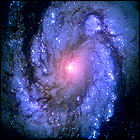 Following the Space Shuttle repair mission to the Hubble Space Telescope, the orbiting telescope’s new Wide Field and Planetary Camera 2 shows incredible improvement in image resolution. By determining the exact deformation of the telescope’s main mirror, the new camera is created almost like corrective glasses: it’s designed to compensate for that deformation at all times. The resulting improvement in image quality is remarkable, enabling Hubble to spot volcanic activity on Io, a moon of Jupiter whose volcanoes have only been visible from space probes making a close flyby. Hubble’s improved vision also arrives just in time to witness an unprecedented event: a cometary collision with Jupiter later in 1994.
Following the Space Shuttle repair mission to the Hubble Space Telescope, the orbiting telescope’s new Wide Field and Planetary Camera 2 shows incredible improvement in image resolution. By determining the exact deformation of the telescope’s main mirror, the new camera is created almost like corrective glasses: it’s designed to compensate for that deformation at all times. The resulting improvement in image quality is remarkable, enabling Hubble to spot volcanic activity on Io, a moon of Jupiter whose volcanoes have only been visible from space probes making a close flyby. Hubble’s improved vision also arrives just in time to witness an unprecedented event: a cometary collision with Jupiter later in 1994.
Comet Shoemaker-Levy 9
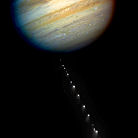 Astronomers on Earth discover a comet like none seen before: having flown close to Jupiter in July 1992, the comet has broken into multiple pieces in a configuration that its discoverers call “a string of pearls.” Calculations of the orbit of the newly detected comet, named Shoemaker-Levy 9 after the team that discovered it, reveal something stunning: the orbit of the fragments will bring them back to Jupiter in just over a year, at which point they are expected to collide with the planet rather than pass it by or go into orbit. Not only does this give Earth-based astronomers time to coordinate observations, but NASA has an ace in the hole: the entire event will be witnessed by the unmanned Galileo probe as it makes its final approach to the giant planet.
Astronomers on Earth discover a comet like none seen before: having flown close to Jupiter in July 1992, the comet has broken into multiple pieces in a configuration that its discoverers call “a string of pearls.” Calculations of the orbit of the newly detected comet, named Shoemaker-Levy 9 after the team that discovered it, reveal something stunning: the orbit of the fragments will bring them back to Jupiter in just over a year, at which point they are expected to collide with the planet rather than pass it by or go into orbit. Not only does this give Earth-based astronomers time to coordinate observations, but NASA has an ace in the hole: the entire event will be witnessed by the unmanned Galileo probe as it makes its final approach to the giant planet.
The World Wide Web
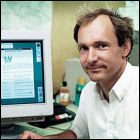 The World Wide Web is born as Tim Berners-Lee shows off his concept for implementing hypertext, consisting of cross-linked documents, on the internet. At the time of his demonstration, the net’s primary functions are Gopher, Telnet and Usenet, but as those services do not provide a simple, user-friendly experience for providing amusingly captioned cat pictures to the public, “the web”, also known as “the WWW”, quickly gains traction and prominence. While the internet’s infrastructure can trace its origins to the 1960s and ARPAnet, this marks the dawn of the public-facing internet (which now, of course, includes the site you are reading right now).
The World Wide Web is born as Tim Berners-Lee shows off his concept for implementing hypertext, consisting of cross-linked documents, on the internet. At the time of his demonstration, the net’s primary functions are Gopher, Telnet and Usenet, but as those services do not provide a simple, user-friendly experience for providing amusingly captioned cat pictures to the public, “the web”, also known as “the WWW”, quickly gains traction and prominence. While the internet’s infrastructure can trace its origins to the 1960s and ARPAnet, this marks the dawn of the public-facing internet (which now, of course, includes the site you are reading right now).
The People vs. Galileo?
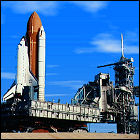 A lawsuit, filed by environmental activists worried about the release of plutonium from the Galileo Jupiter probe’s radioisotope thermoelectric generators in the event of a Challenger-like disaster during launch, is dismissed by a federal judge; the President of the United States has also given permission for the launch to proceed (a requirement anytime a nuclear-fueled spacecraft is in the works). The suit, filed earlier in the year, sought an injunction to prevent Galileo from being launched. Times have changed since the last RTG-powered flight (the Voyager missions of the 1970s), and activists are concerned about a Chernobyl-style radioactive disaster, although the plutonium 238 at the heart of Galileo’s power supply (and that of other interplanetary probes that have used it) is non-weapons-grade and non-fissible. Galileo is slated to be launched in a week aboard the space shuttle Atlantis.
A lawsuit, filed by environmental activists worried about the release of plutonium from the Galileo Jupiter probe’s radioisotope thermoelectric generators in the event of a Challenger-like disaster during launch, is dismissed by a federal judge; the President of the United States has also given permission for the launch to proceed (a requirement anytime a nuclear-fueled spacecraft is in the works). The suit, filed earlier in the year, sought an injunction to prevent Galileo from being launched. Times have changed since the last RTG-powered flight (the Voyager missions of the 1970s), and activists are concerned about a Chernobyl-style radioactive disaster, although the plutonium 238 at the heart of Galileo’s power supply (and that of other interplanetary probes that have used it) is non-weapons-grade and non-fissible. Galileo is slated to be launched in a week aboard the space shuttle Atlantis.
Voyager 2 and the lost moon of Neptune
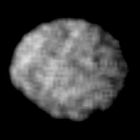 First spotted by Earth-based telescope observations in 1981, Neptune’s fourth-largest natural satellite was so tiny and dark that follow-up observations to confirm the discovery were unsuccessful…at least until Voyager 2 sights it on approach to the eighth planet, finding a tiny moon whose orbit corresponds to the theoretical orbit of the body originally sighted in 1981. In 1991, the International Astronomical Union will name this moon Larissa.
First spotted by Earth-based telescope observations in 1981, Neptune’s fourth-largest natural satellite was so tiny and dark that follow-up observations to confirm the discovery were unsuccessful…at least until Voyager 2 sights it on approach to the eighth planet, finding a tiny moon whose orbit corresponds to the theoretical orbit of the body originally sighted in 1981. In 1991, the International Astronomical Union will name this moon Larissa.
The changing climate
 A leading NASA climate scientist, Dr. James E. Hansen, addresses the United States Congress with a warning: the past five months of 1988, the hottest months in the history of weather records, are the beginning of a dangerous trend in Earth’s climate history, and studies conducted by experts show that the cause is increasing man-made pollution. Though Hansen’s claims will continue to be debated for decades (while only slow progress is made in the transition from fossil fuels to renewable energy in that same time), the five-month period in question will not be the last consecutive stretch of rising worldwide temperatures.
A leading NASA climate scientist, Dr. James E. Hansen, addresses the United States Congress with a warning: the past five months of 1988, the hottest months in the history of weather records, are the beginning of a dangerous trend in Earth’s climate history, and studies conducted by experts show that the cause is increasing man-made pollution. Though Hansen’s claims will continue to be debated for decades (while only slow progress is made in the transition from fossil fuels to renewable energy in that same time), the five-month period in question will not be the last consecutive stretch of rising worldwide temperatures.
GOES-7 goes up
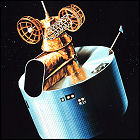 NOAA’s GOES-7 Geostationary Operational Environmental Satellite is launched from Cape Canaveral into a geosynchronous orbit now designated GOES-EAST to monitor weather patterns over the United States. Originally intended for a 1986 launch, GOES-7 has been kept on the ground by the investigation into the destruction just after launch of its predecessor, GOES-G. GOES-7 will become the first of the GOES satellites to operate in both the GOES-EAST and GOES-WEST orbits, and will be retired from active weather-watching duty in 1999, becoming a communications relay satellite until it is decommissioned in 2012.
NOAA’s GOES-7 Geostationary Operational Environmental Satellite is launched from Cape Canaveral into a geosynchronous orbit now designated GOES-EAST to monitor weather patterns over the United States. Originally intended for a 1986 launch, GOES-7 has been kept on the ground by the investigation into the destruction just after launch of its predecessor, GOES-G. GOES-7 will become the first of the GOES satellites to operate in both the GOES-EAST and GOES-WEST orbits, and will be retired from active weather-watching duty in 1999, becoming a communications relay satellite until it is decommissioned in 2012.
Supernova 1987A
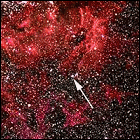 Astronomers both amateur and professional glimpse the first supernova to occur in the age of modern science. Given the name Supernova 1987A, the huge burst of light – visible to the naked eye in Earth’s southern hemisphere by the early summer months of 1987 before it begins fading out – is a collapsing star on the edge of the Tarantula Nebula. The star previously seen in that location is a blue supergiant, which wasn’t a likely candidate to go nova according to the existing theories of stellar evolution at the time. In the 1990s, the slowly expanding ring of debris rushing outward from Supernova 1987A becomes a favorite observation target for the Hubble Space Telescope. The supernova is more than 150,000 light years away from Earth’s solar system in the direction of the Large Magellenic Cloud.
Astronomers both amateur and professional glimpse the first supernova to occur in the age of modern science. Given the name Supernova 1987A, the huge burst of light – visible to the naked eye in Earth’s southern hemisphere by the early summer months of 1987 before it begins fading out – is a collapsing star on the edge of the Tarantula Nebula. The star previously seen in that location is a blue supergiant, which wasn’t a likely candidate to go nova according to the existing theories of stellar evolution at the time. In the 1990s, the slowly expanding ring of debris rushing outward from Supernova 1987A becomes a favorite observation target for the Hubble Space Telescope. The supernova is more than 150,000 light years away from Earth’s solar system in the direction of the Large Magellenic Cloud.
GOES-G goes nowhere fast
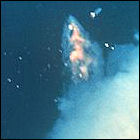 NOAA’s GOES-G Geostationary Operational Environmental Satellite is launched from Cape Canaveral, intended to replace the failed GOES-5 satellite in a geosynchronous orbit over Earth’s western hemisphere. But an electrical fault destroys GOES-G’s Delta booster in flight, and the rocket explodes 71 seconds into its flight. This is NASA’s first attempt to launch a rocket since the Space Shuttle Challenger disaster earlier in 1986, raising new questions about the space agency’s reliability and safety record.
NOAA’s GOES-G Geostationary Operational Environmental Satellite is launched from Cape Canaveral, intended to replace the failed GOES-5 satellite in a geosynchronous orbit over Earth’s western hemisphere. But an electrical fault destroys GOES-G’s Delta booster in flight, and the rocket explodes 71 seconds into its flight. This is NASA’s first attempt to launch a rocket since the Space Shuttle Challenger disaster earlier in 1986, raising new questions about the space agency’s reliability and safety record.
The Chernobyl disaster
 A major accident at the #4 reactor of the Soviet Union’s Chernobyl nuclear power facility, near the border of Ukraine and Belarus, causes a significant release of radioactive material into the air. Much of the material has immediate consequences for the nearby city of Pripyat, but the effects are felt both elsewhere in the Soviet Union and in Europe. Worse still, the Soviet government tries to cover up the incident, until the mounting evidence of a major incident forces them to admit, two days after the fact, that a core meltdown occurred and that the resulting release of radioactive material has international reach and consequences. Some emergency workers die of massive radiation exposure, and an increase is seen in other illnesses, including cancer, in exposed human populations nearby. Over 100,000 people are evacuated from nearby areas. Premature deaths and genetic mutations are observed in nearby wildlife for years after the incident. The costs of mitigation and containment of the toxic reactor site will become a major factor in the collapse of the Soviet Union a few years later. The exclusion zone established around the facility may be a safe place for humans to live again for hundreds, perhaps thousands, of years.
A major accident at the #4 reactor of the Soviet Union’s Chernobyl nuclear power facility, near the border of Ukraine and Belarus, causes a significant release of radioactive material into the air. Much of the material has immediate consequences for the nearby city of Pripyat, but the effects are felt both elsewhere in the Soviet Union and in Europe. Worse still, the Soviet government tries to cover up the incident, until the mounting evidence of a major incident forces them to admit, two days after the fact, that a core meltdown occurred and that the resulting release of radioactive material has international reach and consequences. Some emergency workers die of massive radiation exposure, and an increase is seen in other illnesses, including cancer, in exposed human populations nearby. Over 100,000 people are evacuated from nearby areas. Premature deaths and genetic mutations are observed in nearby wildlife for years after the incident. The costs of mitigation and containment of the toxic reactor site will become a major factor in the collapse of the Soviet Union a few years later. The exclusion zone established around the facility may be a safe place for humans to live again for hundreds, perhaps thousands, of years.